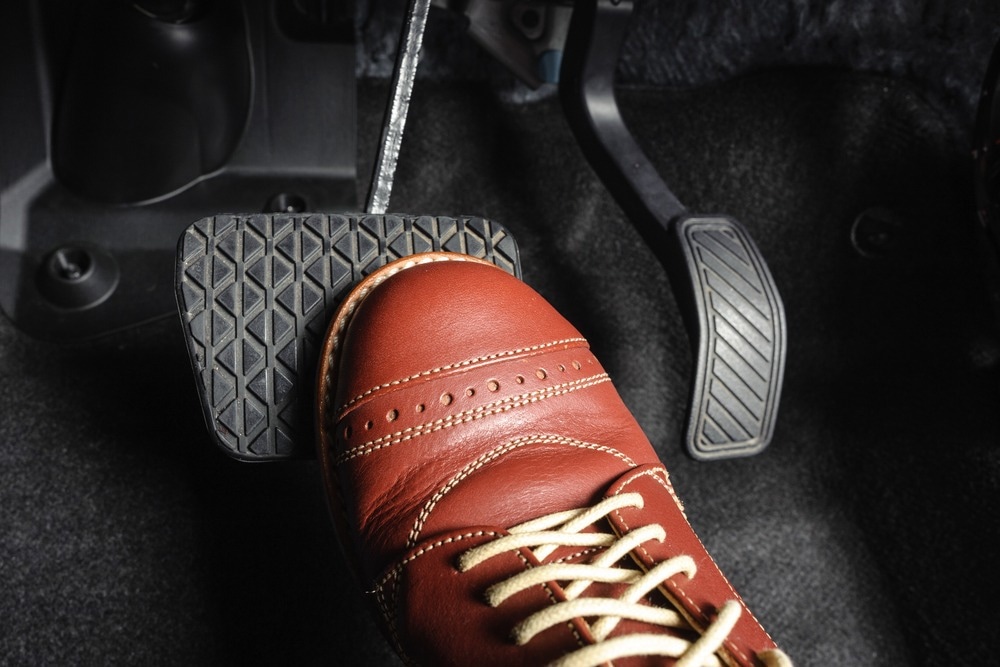The automotive industry is currently in the relatively long process of transitioning to phase out the internal combustion engine. This process involves optimizing every part of the car for alternative drive systems, including brakes.

Image Credit: Nor Gal/Shutterstock.com
A new electromechanical brake system sensor, recently brought to market by Sensata Technologies, exceeds the demands of compatibility, improving response time by capturing drivers’ intention to brake before they even move their feet.
Updating Brake Systems for Electrification and Automation
Cutting-edge brake technology is following the automotive industry’s “x-by-wire” trend by moving away from mechanical, hydraulic brakes toward all-electric “brake-by-wire” systems.
These all-electric brake systems (as well as hybrid hydraulic-electric brake systems) are being used in the latest hybrid and electric vehicles, and would feature in any future iteration of autonomous driving that meets requirements for safety.
Different safety factors for electric and autonomous vehicles have motivated the development of brake-by-wire and hybrid brake systems. This is because of the different needs for redundancy in electric systems.
In traditional hydraulic brake (and steering) systems, the output is mechanically linked to the input. As long as the brake line is connected, the brake will nearly always respond to pressure on the brake pedal. In-built redundancies in the hydraulic system ensure the system will continue to work safely even if parts of it stop working.
Such a level of failsafe is not present in single electric systems, which is why redundancy needs to be built into x-by-wire platforms differently. This can be achieved by running parallel, identical sensors to output circuits, or by running two different systems at the same time.
Despite the need for different safety approaches, moving away from hydraulic brake systems will still benefit cars of the future. There are significant weight and manufacturing complexity advantages to “dry” or hydraulics-free brake systems, which affect battery range and product price point, respectively.
Electro-hydraulic and fully drive electromechanical brakes require extremely reliable sensors to work safely. Sensors replace the hydraulic fluid in traditional brake systems and relay drivers’ instructions to the brake component.
This need actually presents an opportunity to improve on the brake performance of traditional cars. With modern sensing and data processing technologies, sensors can even improve brake response time.
How Do Sensata Technologies’ Brake Pedal Force Sensors Work?
Sensata Technologies recently launched a brake pedal force sensor that the company claims reduces vehicle stopping time. The sensor can accurately and quickly identify the driver’s intent to brake before they even press the pedal.
The product is an electromechanical sensor that is fitted onto the toe end of the brake pedal in a car. It captures the intent to start braking, improving brake reaction, and is compatible with electrified and automated driving systems.
The sensor can withstand forces up 600 N and is scalable to other forces. It meets functional safety requirements, and it can be used in temperatures up to 140 °C (285 °F). According to Sensata, it improves response time by over 10 milliseconds. The sensor can also alert drivers of autonomous systems if the brake pedal is stuck.
Brake to the Future
Sensata’s sensor is designed to work with the brake pedals of the past, present, and future. It is compatible with hydraulic, electro-hydraulic, and full brake-by-wire braking platforms.
Market experts expect the automotive industry to transition away from hydraulic brakes in the coming years. However, this is not expected to be a sudden transition, as car production processes are planned decades in advance and must work with extremely complex logistics arrangements.
The hydraulic brakes in use today are little changed from a design that was first introduced over a hundred years ago. First, these will be phased out in favor of electro-hydraulic brake systems. These remove the connection between the brake pedal and the actual brake but still use hydraulics to generate the required brake system. They are much lighter and smaller than conventional hydraulic brakes, however, and more suitable for electric vehicles.
The end of this forecast transition will be brake-by-wire systems in most production cars. These may supplement other brake systems or work alongside other electric systems to create all-electric redundancy.
Alternative Approaches for Future Brake Systems
As well as the pedal force sensors recently released by Sensata Technologies, other future brake systems are applying position sensors or a combination of force sensors and position sensors.
Position sensors measure the position traveled by a brake pedal as well as the amount of force applied (by measuring the pedal’s acceleration). This data is used to output instructions for the brake component. Position sensors benefit from increased accuracy, which enables precise brake system control. However, they can be oversensitive to noise, and there are maintenance concerns around their moving parts over time.
Force sensors like Sensata’s convert input mechanical loads into an output signal. Force sensors can uniquely sense pre-movement force to capture drivers’ braking intent, increasing brake response time. The low form factor of these systems also provides more design freedom for automotive engineers.
References and Further Reading
Els, P. (2019). Braking and steering systems to control a new generation of autonomous vehicle. [Online] https://www.automotive-iq.com/chassis-systems/columns/braking-and-steering-systems-to-control-a-new-generation-of-autonomous-vehicle
NEXT GENERATION BRAKE PEDAL SENSING TECHNOLOGIES FOR ELECTROMECHANICAL BRAKE SYSTEMS. (2022) [Online] Sensata Technologies. Available at: www.sensata.com/
Sensata Technologies’ New Brake Pedal Force Sensor Enables Safer Brakes for Next Generation Cars. (2022) [Online] UK Tech News. Available at: https://www.uktech.news/technology_news/sensata-technologies-new-brake-pedal-force-sensor-enables-safer-brakes-for-next-generation-cars
Stockmar, J., (2015). Developments in Automotive Brake Technology: The Future of Braking. [Online] Automotive iQ. Available at: https://www.automotive-iq.com/chassis-systems/interviews/developments-in-automotive-brake-technology-the-fu
Disclaimer: The views expressed here are those of the author expressed in their private capacity and do not necessarily represent the views of AZoM.com Limited T/A AZoNetwork the owner and operator of this website. This disclaimer forms part of the Terms and conditions of use of this website.